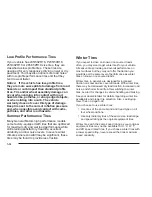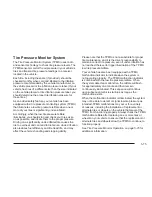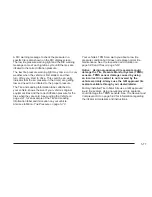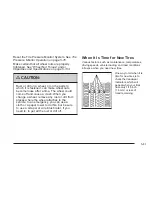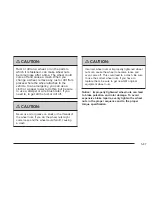
Tire Pressure Monitor System
The Tire Pressure Monitor System (TPMS) uses radio
and sensor technology to check tire pressure levels. The
TPMS sensors monitor the air pressure in your vehicle’s
tires and transmit tire pressure readings to a receiver
located in the vehicle.
Each tire, including the spare (if provided), should be
checked monthly when cold and inflated to the inflation
pressure recommended by the vehicle manufacturer on
the vehicle placard or tire inflation pressure label. (If your
vehicle has tires of a different size than the size indicated
on the vehicle placard or tire inflation pressure label, you
should determine the proper tire inflation pressure for
those tires.)
As an added safety feature, your vehicle has been
equipped with a tire pressure monitoring system (TPMS)
that illuminates a low tire pressure telltale when one or
more of your tires is significantly under-inflated.
Accordingly, when the low tire pressure telltale
illuminates, you should stop and check your tires as so
on as possible, and inflate them to the proper pressure.
Driving on a significantly under-inflated tire causes the
tire to overheat and can lead to tire failure. Under-inflation
also reduces fuel efficiency and tire tread life, and may
affect the vehicle’s handling and stopping ability.
Please note that the TPMS is not a substitute for proper
tire maintenance, and it is the driver’s responsibility to
maintain correct tire pressure, even if under-inflation has
not reached the level to trigger illumination of the TPMS
low tire pressure telltale.
Your vehicle has also been equipped with a TPMS
malfunction indicator to indicate when the system is
not operating properly. The TPMS malfunction indicator
is combined with the low tire pressure telltale. When
the system detects a malfunction, the telltale will flash
for approximately one minute and then remain
continuously illuminated. This sequence will continue
upon subsequent vehicle start-ups as long as the
malfunction exists.
When the malfunction indicator is illuminated, the system
may not be able to detect or signal low tire pressure as
intended. TPMS malfunctions may occur for a variety
of reasons, including the installation of replacement or
alternate tires or wheels on the vehicle that prevent the
TPMS from functioning properly. Always check the TPMS
malfunction telltale after replacing one or more tires or
wheels on your vehicle to ensure that the replacement or
alternate tires and wheels allow the TPMS to continue to
function properly.
See Tire Pressure Monitor Operation on page 5-76 for
additional information.
5-75
Содержание 2009 CTS
Страница 6: ...NOTES vi...
Страница 146: ...NOTES 2 68...
Страница 149: ...NOTES 3 3...
Страница 150: ...Instrument Panel Overview CTS Shown CTS V Similar 3 4...
Страница 178: ...United States V Series Automatic Transmission Cluster shown Manual and Canada similar 3 32...
Страница 322: ...CTS V When you open the hood on the 6 2L Super Charged engine you will see the following 5 16...
Страница 434: ...Relays Usage FUEL PUMP Fuel Pump LCK Lock Relays Usage LT POS LP Left Position Lamp REAR FOG Not Used 5 128...
Страница 457: ...Engine Drive Belt Routing CTS CTS V 6 17...
Страница 459: ...Maintenance Record cont d Date Odometer Reading Serviced By Maintenance Stamp Services Performed 6 19...
Страница 460: ...Maintenance Record cont d Date Odometer Reading Serviced By Maintenance Stamp Services Performed 6 20...




